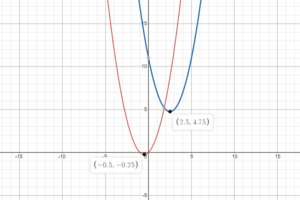Multiple Transformations of Functions
See Single Transformations of Functions for more information on translating, reflecting, compressing, and stretching functions.
Combining Functions
If is some function, then is the function shifted h units horizontally (to the right for h > 0 and to the left for h < 0) and k units vertically (up for k > 0 and down for k < 0). For example, is the function shifted 3 units to the right and 5 units up. is the function shifted 2 units to the left and 6 units down.
The order that two transformations are applied can change the resulting function. A vertical transformation and a horizontal transformation can be applied in either order and will result in the same function. However, two vertical transformations or two horizontal transformations can result in differing functions depending on the order they are applied in.
Let for the following examples:
- Vertical shift and horizontal reflection: A 3 unit vertical shift, THEN a horizontal reflection of , will result in the function . If we apply the horizontal reflection first instead, we will still get the result .
- Vertical shift and vertical reflection: A 3 unit vertical shift, THEN a vertical reflection of , will result in the function . However, if we apply the vertical reflection before the vertical shift, we will get the function , which is not equal to our previous result .
- Horizontal reflection and vertical stretch: A horizontal reflection, then a vertical stretch of 2, will give us the function . Switching the order of the transformations will result in the same function.
- Horizontal reflection and horizontal stretch: A horizontal reflection, then a vertical stretch of 2, will give us the function . Switching the order of the transformations will result in the same function.
Resources
- Combining Transformations, University of Houston
- Sequences of Transformations, Lumen Learning














